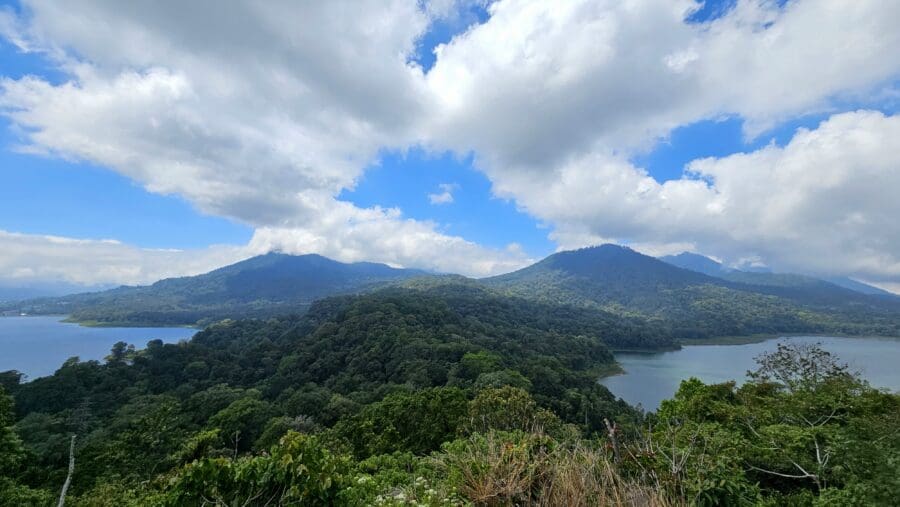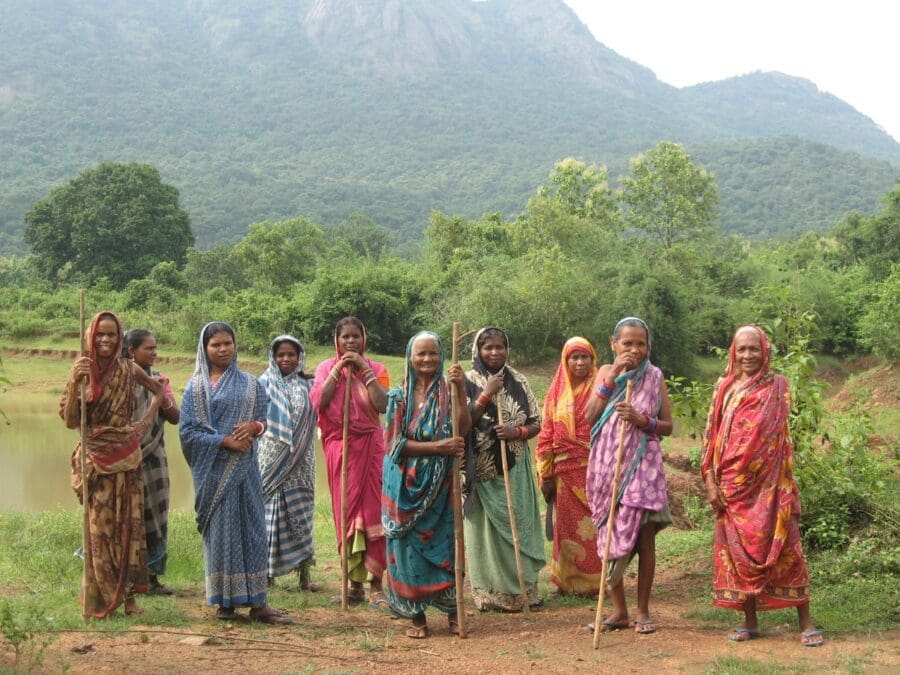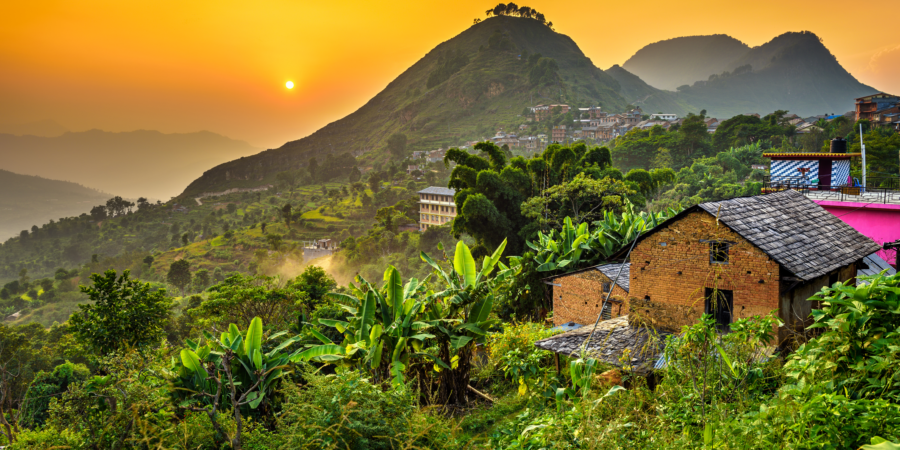Nestled in between 300-year-old trees, hundreds of orchids, and thousands of other plant species—many of which are found nowhere else on Earth—are 17 temples built along the border of the Masyarakat Adat Dalem Tamblingan (MADT)’s territory in northcentral Bali. Standing at 1,300m above sea level with mossed roofs, discrete yellow ornamentations and no walls, the temples blend in with their natural surroundings.
These temples are emblematic of the way the MADT understand their reciprocal relationship with the natural world: Their belief system, known as Piagem Gama Tirta, translates to “reverence for water and living in harmony with nature.”
“We do not call what we do conservation. It’s our daily habit and it is who we are,” said Putu Willy Suputra, a MADT youth trekking guide.
The community recognizes the Alas Mertajati Forest as the source of all life. The name Mertajati literally translates to “source of life” in the local language. Lake Tamblingan, the largest of four lakes in Bali, is similarly believed to have medicinal and life-giving properties. The forest irrigates agricultural, residential, coastal, and tourist areas as far south as Denpasar and the lake supplies the island with nearly one-third of its annual water supply.
In other words, the conservation practices of the MADT benefit not only the community, but also over 4 million people who call Bali home and millions of tourists who visit each year.

What does Indigenous-led conservation look like in Masyarakat Adat Dalem Tamblingan?
The Alas Mertajati Forest and its surrounding area are home to 20,000 MADT members spread across four villages. Their customary territory covers approximately 6,991 hectares of land, including 5,693 hectares of paddy fields, intercrop plantations and village settlements; and 1,298 hectares of forest.
According to historical inscriptions found buried near Lake Tamblingan, Indigenous Peoples have been living in the area since at least the 9th century AD. In the 14th century, the community moved away from Lake Tamblingan to a lower elevation to protect the lake and surrounding forest from soil erosion, degradation and human harm.
“The forest is our temple. We don’t get resources from it. We may take some herbs for medicine, but we don’t use [the forest] for economic purposes. Our purpose is to renature it and return it back to its original state,” said Putu Willy.
What makes the MADT unique is its hyper-local approach to conservation. Rituals and ceremonies are performed to honor the environment and the community’s source of livelihood are activities such as rice farming, agriculture, gardening and commerce.
For example, the Women Farmers’ Group is an Indigenous women-led enterprise consisting of 22 MADT women and girls who sustainably plant, grow, harvest, roast, and package coffee beans to be sold in coffee houses and shops throughout Bali, generating income for the community. The Group collectively processes over 700kg of coffee per month.
The community believes it is their spiritual and moral duty to maintain the integrity of the lands and waters that their families have protected and depended on for centuries. But without legal sovereignty over their customary territory, its ability to protect the territory is constantly under threat.

Threatened by deforestation and degradation
In 1996, the Mertajati Forest and surrounding area of over 1,300 hectares was classified as a Nature Tourism Park by the Indonesian Forest Ministry. Today, the Park is experiencing significant deforestation and forest degradation from illegal logging, monocropping, and water pollution and soil erosion from over-tourism.
In the decades since 1996, community members have noticed that the flowers and fruit trees they planted to perform ceremonies are being stolen. Naturally fallen trees that offer crucial health benefits to the soil and ecosystems that rely on them are being delimbed and carted off into cities to be sold for profit. Illegal logging causes mud and sediment to flow into the lake, impacting local flora and fauna as well as rice production at lower altitudes.
Since the establishment of the Alas Mertajati Forest as a Nature Tourism Park, there have been plans to open up the sacred forest to even more tourism, which would have a significant negative impact on the community. One investor proposed building a gondola over the lake as a tourist attraction but rescinded the proposal after receiving strong opposition. Others have said the community’s ceremonies would be a “good show” and great for local tourism.
“There are things we can tolerate when it comes to outsiders visiting the lake and the forest, but other things we will not. If the government were to offer a permit to build a restaurant or accommodation on the lake, we would fight against this. We would die to protect our lake against this,” said Putu Ardana, a village elder and MADT community leader.
In 2019, the community submitted a formal application to the government for the recognition of its customary territory, but no response has been received at the time of writing.
“It makes me sad for our brothers and sisters in the south and afraid of what [tourism can do] in the future if our land is not recognized,” said Putu.

What’s next for the MADT Indigenous Peoples?
In 2018, MADT members—including women and youth—carried out spatial mapping and sociocultural research to identify forest flora and fauna and published a management plan as part of their application to register Alas Mertajati as a customary forest. Evolving from this experience, the community established its own youth organization, Baga Raksa Alas Mertajati (BRASTI).
Members of BRASTI work together to conserve biodiversity and protect the forests and watersheds that the community depends on through territorial mapping, data collection and digital inscriptions; reforestation, replanting and renaturing initiatives; and education activities to promote intergenerational learning.
“Our land is not something we receive from our ancestors, but something we give to our children,” said Diandra Orrisa, a youth leader and member of BRASTI.
Now BRASTI co-leads the MADT’s struggle for rights alongside village leaders with support from Yayasan Wisnu, Working Group for ICCAs in Indonesia (WGII), and Badan Registrasi Wilayah Adat (BRWA). They are fighting to reclaim the community’s customary forest from Nature Reserve Park status.

The community has expressed its willingness and openness to work with government officials to expand and improve their recognition proposal. Before a customary forest is recognized, communities in Indonesia must first receive recognition from the sub-national government through a regulation policy or regional head decree recognizing them as subjects of law.
After that, the community can submit their customary forest proposal to the Ministry of Environment and Forestry, but this process will depend on the government’s political will. Besides this bureaucracy issue, sub-national and national recognition is also expensive. RRI partner, Aliansi Masyarakat Adat Nusantara (AMAN), estimates that the financial resources needed to support the recognition process at the sub-national level can reach up to 2 billion Rupiah (nearly US$130,000). Other Indigenous communities in Indonesia waited 20 years—or more—to gain their recognition.
In the MADT case, the sub-national government refused to sign the MADT territory’s map due to Provincial Regulation on Desa Adat Bali No. 4, Year 2023, which recognized Desa Adat (Indigenous villages) but did not recognize MADT as a social unit of society. The Ministry of Environment and Forestry is unable to proceed with its recognition due to the absence of this sub-national recognition.
The MADT will continue their struggle to secure formal recognition from the government, as the only way to give them power to fight against destructive threats in the future, sustain their territories and livelihoods, and ensure a just and healthy environment for the next generations.
“Even if the process takes 500 years, we will keep fighting for recognition,” said Putu Ardana.
###
Note: From September 17–21, 2023, BRWA, Yayasan Wisnu, and RRI organized a media site visit to the MADT to document and amplify the community’s land rights struggle at the national and international levels. Two journalists, Michael Taylor (Reuters) and Pandu Mustika (Kompas) joined us on the trip.
This blog post would not have been possible without the generosity and kindness of the MADT, whose story deserves to be told until justice is won.









